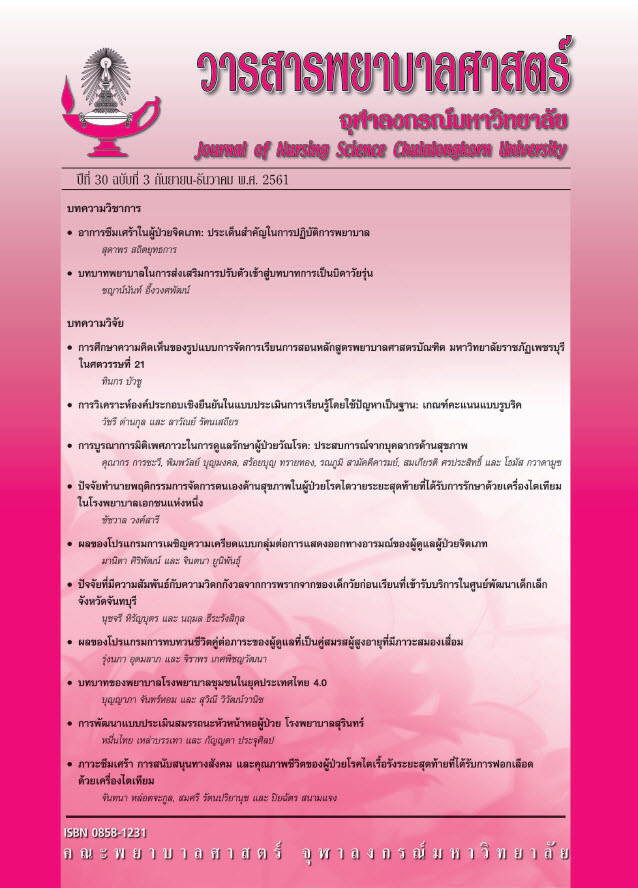บทสะท้อนประสบการณ์การบูรณาการมิติเพศภาวะในงานวัณโรคของผู้ให้บริการ
บทคัดย่อ
วัตถุประสงค์: เพื่อศึกษาประสบการณ์ของผู้ให้บริการในระบบบริการสุขภาพที่ประยุกต์ใช้การบูรณาการมิติเพศภาวะในการปฏิบัติงานดูแลผู้ป่วยวัณโรค
แบบแผนการวิจัย: การวิจัยใช้ระเบียบวิธีวิจัยแบบปฏิบัติการแบบมีส่วนร่วม
วิธีดำเนินการวิจัย: ผู้ให้ข้อมูลคือ ผู้ให้บริการในระบบบริการสุขภาพที่ดูแล รักษาผู้ป่วยวัณโรค คัดเลือกแบบเจาะจงจากโรงพยาบาลรัฐใน 5 จังหวัด จำนวน 78 ราย เก็บข้อมูลด้วยการสังเกต สัมภาษณ์เชิงลึกและสนทนากลุ่ม การวิเคราะห์ข้อมูลใช้การให้รหัสแบบเปิด
ผลการวิจัย: ประสบการณ์ของผู้ให้บริการในการดูแลผู้ป่วยวัณโรคโดยใช้การบูรณาการมิติเพศภาวะ แบ่งออกได้ 4 ประเด็น ดังนี้ 1) ประสบการณ์การวิเคราะห์เพศภาวะในการเยี่ยมบ้านผู้ป่วยวัณโรค 2) ประสบการณ์การบูรณาการมิติเพศภาวะในความสัมพันธ์ระหว่างผู้ให้บริการกับผู้ป่วยเพื่อลดการใช้อำนาจกับผู้ป่วยและเสริมพลังอำนาจให้ผู้ป่วย 3) ประสบการณ์การบูรณาการมิติเพศภาวะในการทำงานระดับชุมชนเพื่อลดการตีตราผู้ป่วยในชุมชน และ 4) ประสบการณ์การบูรณาการมิติเพศภาวะในการจัดระบบบริการสุขภาพ
สรุป: ประสบการณ์ของผู้ให้บริการที่ประยุกต์การบูรณาการมิติเพศภาวะและการวิเคราะห์เพศภาวะในการดูแลผู้ป่วยวัณโรคในทุกๆ ขั้นตอนมีความสำคัญอย่างยิ่ง และสามารถนำไปใช้วางแผนด้านการพยาบาลในการดูแลผู้ป่วยวัณโรค และผู้ป่วยที่มีปัญหาด้านสุขภาพอื่นๆ ได้ต่อไป
เอกสารอ้างอิง
Boonmongkon, P., Saithong, S., Samakkeekarom, R., Sornprasit, S., & Kanchawee, K. (2014). Gender mainstreaming in tuberculosis care services for tuberculosis patients and
tuberculosis patients living with HIV. Nakhon Pathom: Center for Health Policy Studies, Faculty of Social Sciences and Humanities, Mahidol University.
Eastwood, S. V., & Hill, P. C. (2004). A gender-focused qualitative study of barriers to accessing tuberculosis treatment in The Gambia, West Africa. The International Journal of
Tuberculosis and Lung Disease, 8(1), 70–75.
Gosoniu, G. D., Ganapathy, S., Kemp, J., Auer, C., Somma, D., Karim, F., & Weiss, M. G. (2008). Gender and socio-cultural determinants of delay to diagnosis of TB in Bangladesh,
India and Malawi. Int J Tuberc Lung Dis, 12(7), 848–855.
Hudelson, P. (1996). Gender differentials in tuberculosis: The role of socio-economic and cultural factors. Tubercle and Lung Disease, 77(5), 391–400. https://doi.org/10.1016/S0962-
8479(96)90110-0
Johansson, E., Diwan, V. K., Huong, N. D., & Ahlberg, B. M. (1996). Staff and patient attitudes to tuberculosis and compliance with treatment: An exploratory study in a district in
Vietnam. Tubercle and Lung Disease, 77(2), 178–183. https://doi.org/10.1016/S0962-8479(96)90035-0
Khan, K. (2012). Understanding the Gender Aspects of Tuberculosis: A Narrative Analysis of the Lived Experiences of Women With TB in Slums of Delhi, India. Health Care for Women
International, 33(1), 3–18.
Kipp, A., Pungrassam, P., Nilmanat, N., Baral, S., Beeker, C., Strauss, R., … Rie, A. (2011). Socio-demographic and AIDS-related factors associated with tuberculosis stigma in
southern Thailand: a quantitative, cross-sectional study of stigma among patients with TB and healthy community members. BMC Public Health, 11(1), 675–683.
Leiter, M. P., & Maslach, C. (1988). The impact of interpersonal environment on burnout and organizational commitment. Journal of Organizational Behavior, 9(4), 297–308.
https://doi.org/10.1002/job.4030090402
Long, N. H., Johansson, E., Diwan, V. K., & Winkvist, A. (1999). Different tuberculosis in men and women: beliefs from focus groups in Vietnam. Social Science & Medicine, 49(6), 815–
822. https://doi.org/10.1016/S0277-9536(99)00171-9
Long, N. H., Johansson, E., Diwan, V. K., & Winkvist, A. (2001). Fear and social isolation as consequences of tuberculosis in VietNam: a gender analysis. Health Policy, 58(1), 69–81.
Ngamvithayapong, J., Yanai, H., Winkvist, A., & Diwan, V. (2001, November 1). Health seeking behaviour and diagnosis for pulmonary tuberculosis in an HIV-epidemic mountainous
area of Thailand [Text]. Retrieved June 5, 2018, from https://www.ingentaconnect.com/content/iuatld/ijtld/2001/00000005/00000011/art00006#
Samakkeekarom, R., Boonmongkon, P., & Subongkot, V. (2013). Political Economy and Social Representation of Tuberculosis Patients, 9(1), 106–118.
Samakkeekarom, R., & Limsomboon, P. (2014). Challenges in Tuberculosis Control in Thailand in the Context of Borderless Movement of Diseases, 10(2), 21–37.
Somma, D., Auer, C., Abouihia, A., & Weiss, M. G. (2005). Gender in Tuberculosis research. Geneva: World Health Organization.
Thorson, A., & Johansson, E. (2004). Equality or equity in health care access: a qualitative study of doctors’ explanations to a longer doctor’s delay among female TB patients in
Vietnam. Health Policy, 68(1), 37.
Weiss, M. G. (2001). Cultural epidemiology: an introduction and overview. Anthropology & Medicine, 8(1), 5–29.
Weiss, M. G., Auer, C., Somma, D., Abouihia, A., Jawahar, M. S., Karim, F., … Kemp, J. (2006). Gender and Tuberculosis: Cross-site Analysis and Implications of a Multi-country Study
in Bandladesh, India, Malawi, and Colombia. World Health Organization.
World Health Organization. (1997). Treatment of tuberculosis: guidelines for national programmes. Geneva: World Health Organization.
World Health Organization. (2002a). An expanded DOTS framework for effective tuberculosis control. Geneva: World Health Organization.
World Health Organization. (2002b). The global plan to stop tuberculosis. Geneva: World Health Organization.
World Health Organization. (2006). World health statistics 2006 (Vol. 2006). Geneva: World Health Organization. Retrieved from https://public.eblib.com/choice/publicfullrecord.aspx?
p=284708
World Health Organization. (2013). World health statistics 2013. [Place of publication not identified]: World Health Organization.
Wright, T. A., & Bonett, D. G. (1997). The Contribution of Burnout to Work Performance. Journal of Organizational Behavior, 18(5), 491–499.
Wynne, A., Richter, S., Jhangri, G., S., Alibhai, A., Rubaale, T., & Kipp, W. (2014). Tuberculosis and human immunodeficiency virus: exploring stigma in a community in western
Uganda. AIDS Care, 26(8), 940–946. https://doi.org/10.1080/09540121.2014.882488
เผยแพร่แล้ว
ฉบับ
ประเภทบทความ
สัญญาอนุญาต
ลิขสิทธิ์ (c) 2019 วารสารพยาบาลศาสตร์ จุฬาลงกรณ์มหาวิทยาลัย

อนุญาตภายใต้เงื่อนไข Creative Commons Attribution-NonCommercial-NoDerivatives 4.0 International License.
ลิขสิทธิ์ของบทความที่ตีพิมพ์เป็นของวารสารพยาบาลศาสตร์ จุฬาลงกรณ์มหาวิทยาลัย ทั้งฉบับตีพิมพ์เป็นรูปเล่มและเอกสารออนไลน์



